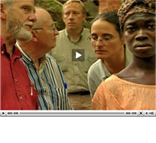

The Slave Trade Business
Slave traders like the DeWolfs took part in what is often known as the “Triangle Trade,” which, in the case of the U.S. trade, included New England, Africa, and slave markets in North America and the Caribbean. New England traders would send ships loaded with rum and other goods to the coast of Africa, to trade for enslaved Africans. Those ships would then take their human cargos across the “Middle Passage” to ports in Caribbean islands or the southern U.S. states. There, they would sell the slaves and often buy cargos of sugar cane, molasses, and other goods produced with slave labor, to bring north to markets in New England. Distillers in the northeast would then make rum from the sugar cane, which in turn could be sold in Africa for more slaves.
The DeWolf family found many ways to increase their profits from the slave trade. In Havana, Cuba, their ship captains could sell their cargoes in one of the largest slave markets in the world. If, however, prices were low when ships arrived, the captains could send the enslaved Africans to sugar plantations owned by the DeWolfs, where the slaves would be worked, produced the raw materials for northern rum distilleries, until prices in the slave market had risen again.
The DeWolfs also used the wealth gained in trading slaves to diversify their holdings and establish other, related businesses. Members of the DeWolf family eventually owned a bank, an insurance company, and rum distilleries. Eventually, James D’Wolf invested in textile mills, where, in an early example of industrialization, cotton grown on southern slave plantations with inexpensive slave labor was spun into fabric.
The slave trade helped to build the growing economies of northern seaports like Bristol, and supported the economies of many towns along the New England coast or further inland. Slave traders paid shipbuilders, insurers, blacksmiths, and a wide variety of other tradesmen, merchants, and farmers. New York financial institutions were heavily invested in slavery. Almost every business and industry in the region traded or did business with merchants or shippers whose wealth was generated by slavery. In addition, those who invested in slaving voyages came from almost all walks of life: while wealthy families such as the DeWolfs were often significant investors, smaller shares in voyages would be owned by ordinary tradesmen and artisans, such as blacksmiths, masons, bakers, rope-makers, painters, and those engaged in various forms of manual labor.
Sources: Jay Coughtry, The Notorious Triangle: Rhode Island and the African Slave Trade, 1700-1807 (Philadelphia: Temple Press, 1981); David Eltis, Stephen D. Behrendt, David Richardson, and Herbert S. Klein, eds., The Trans-Atlantic Slave Trade: A Database on CD-ROM (Cambridge, 1999); Rachel Chernos Lin, “The Rhode Island Slave-Traders: Butchers, Bakers and Candlestick-Makers,” Slavery and Abolition, Vol. 23, No. 3 (Dec. 2002), pp. 21-38; James Pope-Hennessy, Sins of the Fathers: A Study of the Atlantic Slave Traders, 1441-1807 (New York: Barnes & Noble, 1998); Joanne Pope Melish, Disowning Slavery: Gradual Emancipation and “Race” in New England, 1780-1860 (Ithaca, N.Y.: Cornell University Press, 1998).
